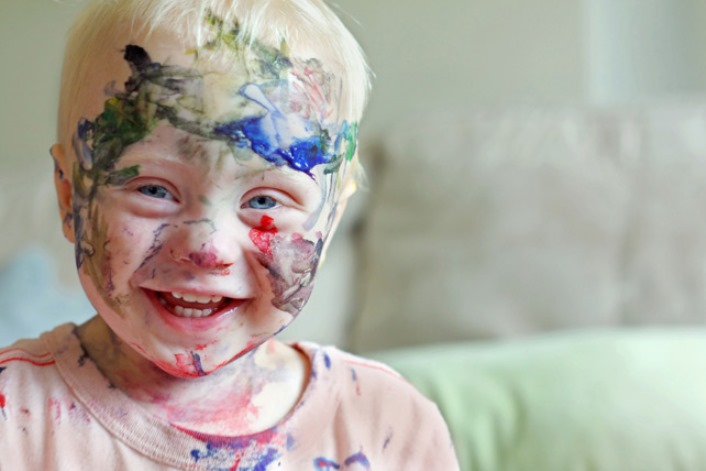Everyone is creative. Everyone. Even your child. Even YOU.
A child doesn’t have to be particularly gifted to be creative. Creatives aren’t just artists or musicians, and creativity doesn’t require unlimited resources nor a disregard for self-control or limits, either. Creative potential can be fostered, improved, exercised, and brought to fruition in any child’s life … and even in a mom’s life.
As education pioneer Sir Ken Robinson explains, creativity is nothing more than “the process of having original ideas that have value.” Creative thinking can be applied to not just artistry, but to any human pursuit on the planet. Math, science, technology, politics, business, communication, teamwork — all these areas of our lives need creative solutions and always gain from seeing things in a fresh way.
PRACTICING CREATIVITY
Moms! Invite another mom over for some creative, fun activities that both of you and your children can do together. The following activities don’t just give your children a chance to be creative; they increase their creative potential going forward. In fact, after trying some of these together, don’t be surprised if your children make better decisions or come up with more ideas. Create a safe space for creativity. If children know they are safe from hurtful criticism, they are much more willing to share thoughts and ideas.
1. Finish the Picture Draw a squiggle or a series of lines on a piece of paper, then ask the child to finish the drawing for you. Try not to give them ideas; instead, ask them, “What could this be?” After the child finishes that drawing, have them draw a squiggle for you to complete for them.
2. What Would Happen If … Ask the following questions (or make up some of your own) and allow as much time as they need to answer. Make sure to also answer the question yourself.
a. What would you do if school was cancelled for a day? Where would you go? What would you do? Who would you do it with? How would you get it done?
b. What if gravity didn’t exist? What in this room would have to change? The neighborhood? The world?
3. The Prop Game Collect a box full of random items from around your house. You and your child take turns pretending to use one or more of the items, but it cannot be used in the way it was meant to be used. For example, don’t use a stockpot to pretend you are cooking, but it might make a nice hat! With a tennis racquet, act out fencing or baseball … or maybe flip pancakes with it!
4. Categories This one works really well on long car rides. Think of a category and together come up with things that fit in it. Categories might be simple or complicated depending on the child’s age or the number of people playing. Consider categories like “Characters in their favorite cartoons /movies with names starting with S,” or “Songs with the word ‘Love’ in the title,” or “Places you can’t go without a boat.” Count your answers, and see if you can break the record on your next try.
5. Color Hunt Take the child for a walk in your neighborhood or go to the park. Pick a color and count how many instances of that color you see on your walk. This encourages the child to look at familiar things in a different way or from a unique perspective — the essence of creative thought.
6. Giant mural Get a roll of butcher paper from your local craft store and tape a large piece on a wall in your home (down a hallway, maybe). Ask everyone in the house to put at least one thing — ANYTHING — on the paper every day for a week, a couple weeks, or even a month. They could write a poem or a prayer, make a drawing, tape up a photo or a clipping from a magazine or newspaper, whatever. It’s fun to watch the mural fill up over time, and something might be placed on it that’s really important for your family to keep.
7. Drawing to music Start some music playing, then start drawing a line on a piece of paper. Change the line based on what you hear. Mark it with the song name and performer. Then try another song. Over time, watch how different songs induce different drawings.
8. Grounding Creativity is deeply connected to emotions. Most creatives can’t make anything when their minds are running like a hamster wheel. Try this easy technique: Notice five things you see, four things you feel, three things you hear, two things you smell, and one thing you taste.
9. Make up a story together Choose someone to go first; that person starts a story. The next person continues the story, and so on. The story could go on for awhile, or you could set a time limit. If you are in a large group, you could end with the last person in the group.
Creativity isn’t all that unique, mysterious, nor elusive, and it certainly can be taught. Not everyone can be Beethoven, Dickens, or Monet, but everyone can sing, write, and draw. And everyone — parents and children alike — can increase their creative potential with practice.
From Moms in Prayer – After a few activities, you could all pray together. Lead the kids in a simple 4 Steps of Prayer format:
The Four Steps of Prayer for your kids
Praise: What is something you love about God?
Confession: What is something you did today you wish you hadn’t?
Thanksgiving: What are you thankful for today?
Intercession: What is something you would like God to help you with?
- PRAY with Moms in Your Community
- SHARE this blog with a friend – click on a social media icon on screen
- Support Our Mission
 Toni Ridgaway has worked closely with kids and teens for 30 years, including 20 years in the local church. She currently works with C.R. Stewart, chair of the Britfield Institute and author of the fast-paced adventure novel, Britfield & the Lost Crown. Mr. Stewart works interactively with schools and organizations nationwide to encourage the reintroduction of creativity, leadership, and innovation to the classroom. Learn more at Britfield.com.
Toni Ridgaway has worked closely with kids and teens for 30 years, including 20 years in the local church. She currently works with C.R. Stewart, chair of the Britfield Institute and author of the fast-paced adventure novel, Britfield & the Lost Crown. Mr. Stewart works interactively with schools and organizations nationwide to encourage the reintroduction of creativity, leadership, and innovation to the classroom. Learn more at Britfield.com.

